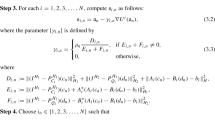Abstract
We present an approach for the solution of a class of generalized semi-infinite optimization problems. Our approach uses augmented Lagrangians to transform generalized semi-infinite min-max problems into ordinary semi-infinite min-max problems, with the same set of local and global solutions as well as the same stationary points. Once the transformation is effected, the generalized semi-infinite min-max problems can be solved using any available semi-infinite optimization algorithm. We illustrate our approach with two numerical examples, one of which deals with structural design subject to reliability constraints.
Similar content being viewed by others
References
M.S. Bazaraa, H.D. Sherall, and C.M. Shetty, Nonlinear Programming. Theory and Algorithms, 2nd edition, Wiley: New York, NY, 1993.
D.P. Bertsekas, Constrained Optimization and Lagrange Multiplier Methods, Academic Press: New York, NY, 1982.
J.F. Bonnans and A. Shapiro, Perturbation Analysis of Optimization Problems, Springer Verlag: New York, NY, 2000.
J.V. Burke, “Calmness and exact penalization,” SIAM J. Control and Optimization, vol. 29, no. 2, pp. 493–497, 1991.
F. Clarke, Optimization and Nonsmooth Analysis, Wiley: New York, NY, 1983.
O. Ditlevsen and H.O. Madsen, Structural Reliability Methods, Wiley: New York, NY, 1996.
O. Fujiwara, S.-P. Han, and O.L. Mangasarian, “Local duality of nonlinear programs,” SIAM J. Control and Optimization, vol. 22, pp. 162–169, 1984.
C. Gonzaga and E. Polak, “On constraint dropping schemes and optimality functions for a class of outer approximations algorithms,” SIAM J. Control and Optimization, vol. 17, no. 4, pp. 477–493, 1979.
T.J. Graettinger and B.H. Krogh, “The acceleration radius: A global performance measure for robotic manipulators,” IEEE J. of Robotics and Automation, vol. 4, pp. 60–69, 1988.
W.W. Hager and D.L. Presler, “Dual techniques for minimax,” SIAM J. Control and Optimization, vol. 25, pp. 660–685, 1987.
R. Hettich and G. Still, “Semi-infinite programming models in robotics,” Parametric Optimization and Related Topics II, J. Goddat et al. (Eds.), Akademie Verlag, Berlin, 1991, pp. 112–118.
H.Th. Jongen, J.-J. Ruckmann, and O. Stein, “Generalized semi-infinite optimization: A first order optimality condition and examples,” Mathematical Programming, vol. 83, pp. 145–158, 1998.
A. Kaplan and R. Tichatschke, “On the numerical treatment of a class of semi-infinite terminal problems,” Optimization, vol. 41, pp. 1–36, 1997.
J. Kyparisis, “On the uniquenss of Kuhn-Tucker multipliers in nonlinear programming,” Mathematical Programming, vol. 32, pp. 242–246, 1985.
E. Levitin, “Reduction of generalized semi-infinite programming problems to semi-infinite or piece-wise smooth programming problems,” Preprint no. 8-2001, University of Trier, Germany, 2001.
E. Levitin and R. Tichatschke, “A branch-and-bound approach for solving a class of generalized semi-infinite programming problems,” J. Global Optimization, vol. 13, pp. 299–315, 1998.
X. Li, “An entropy-based aggregate method for minimax optimization,” Engineering Optimization, vol. 18, pp. 277–285, 1997.
Matlab reference manual, version 5.3, (R11), MathWorks, Inc., Natick, Mass., 1999.
G. Di Pillo, “Exact penalty methods,” in Algorithms for Continuous Optimization: The State of the Art, E. Spedicato (Ed.), Kluwer Academic Pub., Dordrecht, 1994.
E. Polak, Optimization. Algorithms and Consistent Approximations, Springer Verlag: New York, NY, 1997.
B.N. Pshenichnyi and Yu. M. Danilin, Numerical Methods in Extremal Problems (Chislennye Metody v Ekstremal’nykh Zadachakh), Nauka, Moscow, 1975.
R.T. Rockafellar and R.J.-B. Wets, Variational Analysis, Springer-Verlag: New York, NY, 1997.
R.T. Rockafellar, “Augmented Lagrange multiplier functions and duality in nonconvex programming,” SIAM J. Control, vol. 12. no. 2, pp. 268–285, 1974.
J. O. Royset, A. Der Kiureghian, and E. Polak, “Reliability-based optimal structural design by the decoupling approach,” Reliability Engineering and System Safety, Elsevier Science, vol. 73, no. 3, 2001, pp. 213–221.
J.O. Royset, E. Polak, and A. Der Kiureghian, “Adaptive approximations and exact penalization for the solution of generalized semi-infinite min-max problems,” SIAM J. Optimization, vol. 14, no. 1, pp. 1–34, 2003.
J.-J. Ruckmann and A. Shapiro, “On first-order optimality conditions in generalized semi-infinite programming,” J. Optimization Theory and Applications, vol. 101, no. 3, pp. 677–91, 1999.
O. Stein, Bi-Level Strategies in Semi-Infinite Programming, Kluwer Academic: Boston, 2003.
O. Stein, “First order optimality conditions for degenerate index sets in generalized semi-infinite programming,” Mathematics of Operations Research, vol. 26, pp. 565–582, 2001.
O. Stein and G. Still, “On optimality conditions for generalized semi-infinite programming problems,” J. Optimization Theory and Applications, vol. 104, pp. 443–458, 2000.
G. Still, “Generalized semi-infinite programming: theory and methods,” European J. of Operations Research, vol. 119, pp. 301–313, 1999.
G. Still, “Generalized semi-infinite programming: numerical aspects,” Optimization, vol. 49, no. 3, pp. 223–242, 2001.
J.L. Zhou and A.L. Tits, “An SQP algorithm for finely discretized continuous minimax problems and other minimax problems with many objective functions,” SIAM Journal on Optimization, vol. 6, pp. 461–487, 1996.
G.-W. Weber, “Generalized semi-infinite optimization: on some foundations,” Vychislitel’nye Tekhnologii, vol. 4, pp. 41–61, 1999.
Author information
Authors and Affiliations
Corresponding author
Rights and permissions
About this article
Cite this article
Polak, E., Royset, J.O. On the Use of Augmented Lagrangians in the Solution of Generalized Semi-Infinite Min-Max Problems. Comput Optim Applic 31, 173–192 (2005). https://doi.org/10.1007/s10589-005-2179-8
Received:
Revised:
Accepted:
Issue Date:
DOI: https://doi.org/10.1007/s10589-005-2179-8




